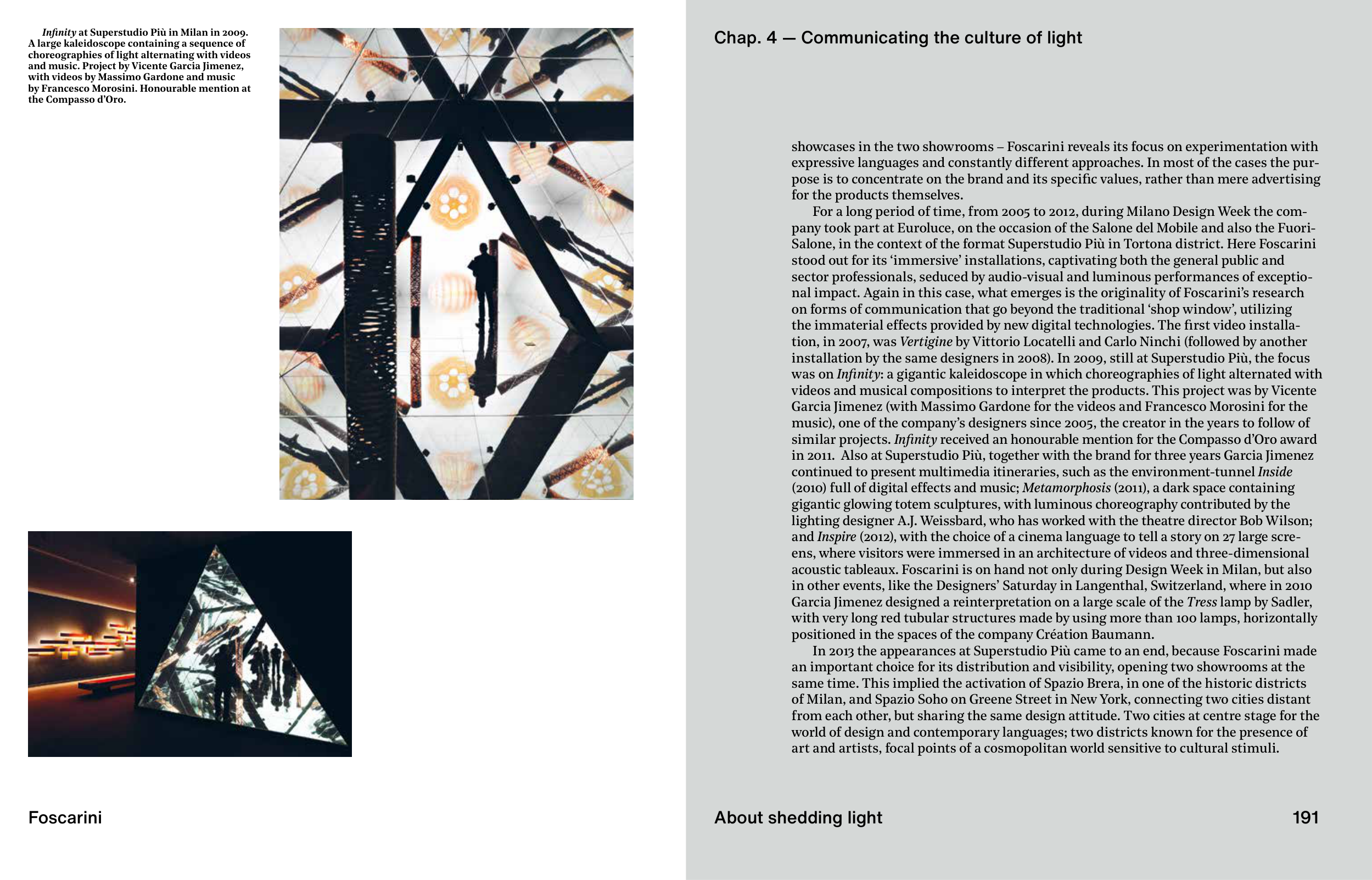Foscarini
191
Infi nity at Superstudio Più in Milan in 2009.
A large kaleidoscope containing a sequence of
choreographies of light alternating with videos
and music. Project by Vicente Garcia Jimenez,
with videos by Massimo Gardone and music
by Francesco Morosini. Honourable mention at
the Compasso d’Oro.
About shedding light
showcases in the two showrooms – Foscarini reveals its focus on experimentation with
expressive languages and constantly different approaches. In most of the cases the pur-
pose is to concentrate on the brand and its specifi c values, rather than mere advertising
for the products themselves.
For a long period of time, from 2005 to 2012, during Milano Design Week the com-
pany took part at Euroluce, on the occasion of the Salone del Mobile and also the Fuori-
Salone, in the context of the format Superstudio Più in Tortona district. Here Foscarini
stood out for its ‘immersive’ installations, captivating both the general public and
sector professionals, seduced by audio-visual and luminous performances of exceptio-
nal impact. Again in this case, what emerges is the originality of Foscarini’s research
on forms of communication that go beyond the traditional ‘shop window’, utilizing
the immaterial effects provided by new digital technologies. The fi rst video installa-
tion, in 2007, was Vertigine by Vittorio Locatelli and Carlo Ninchi (followed by another
installation by the same designers in 2008). In 2009, still at Superstudio Più, the focus
was on Infi nity: a gigantic kaleidoscope in which choreographies of light alternated with
videos and musical compositions to interpret the products. This project was by Vicente
Garcia Jimenez (with Massimo Gardone for the videos and Francesco Morosini for the
music), one of the company’s designers since 2005, the creator in the years to follow of
similar projects. Infi nity received an honourable mention for the Compasso d’Oro award
in 2011. Also at Superstudio Più, together with the brand for three years Garcia Jimenez
continued to present multimedia itineraries, such as the environment-tunnel Inside
(2010) full of digital effects and music; Metamorphosis (2011), a dark space containing
gigantic glowing totem sculptures, with luminous choreography contributed by the
lighting designer A.J. Weissbard, who has worked with the theatre director Bob Wilson;
and Inspire (2012), with the choice of a cinema language to tell a story on 27 large scre-
ens, where visitors were immersed in an architecture of videos and three-dimensional
acoustic tableaux. Foscarini is on hand not only during Design Week in Milan, but also
in other events, like the Designers’ Saturday in Langenthal, Switzerland, where in 2010
Garcia Jimenez designed a reinterpretation on a large scale of the Tress lamp by Sadler,
with very long red tubular structures made by using more than 100 lamps, horizontally
positioned in the spaces of the company Création Baumann.
In 2013 the appearances at Superstudio Più came to an end, because Foscarini made
an important choice for its distribution and visibility, opening two showrooms at the
same time. This implied the activation of Spazio Brera, in one of the historic districts
of Milan, and Spazio Soho on Greene Street in New York, connecting two cities distant
from each other, but sharing the same design attitude. Two cities at centre stage for the
world of design and contemporary languages; two districts known for the presence of
art and artists, focal points of a cosmopolitan world sensitive to cultural stimuli.
Chap. 4 — Communicating the culture of light
191


